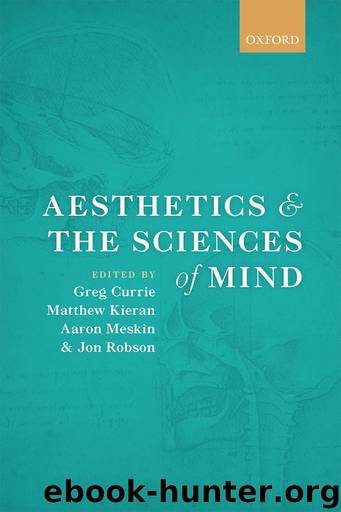Aesthetics and the Sciences of Mind by Greg Currie Matthew Kieran Aaron Meskin and Jon Robson

Author:Greg Currie, Matthew Kieran, Aaron Meskin and Jon Robson
Language: eng
Format: epub
Publisher: Oxford University Press
Published: 2014-05-15T00:00:00+00:00
6.2.3 Objections and replies
One might object that any purported connection between the possession/employment of artistic concepts and that of aesthetic concepts results from conflating the notion of what is required to be (or make) a good artwork with what is necessary to be (or make) artwork simpliciter. Perhaps artists who lack or fail to employ aesthetic concepts may be incapable (perhaps even necessarily incapable) of creating good art; this by itself isn’t enough to ground the required link. For instance, suppose an artist suffers head trauma such that she loses the ability to form or employ aesthetic concepts, and further suppose her work after the accident to be correctly regarded as terribly trivial, mediocre, and uninspiring. Merely from this it does not follow that her work cannot continue to be correctly regarded as art—upon hearing the news of the artist’s accident and subsequent cognitive loss, no one ought to conclude that all post-accident work can’t but fail to be art. Such a metaphysical shift could not result from such cognitive losses. Even were we to grant that aesthetic concept possession on the part of the artist is necessary for the artist to produce artworks with good-making features, to ground the link between art and the aesthetic, the Aesthetic-Concept Theory of Art must entail the claim that artworks must have good-making features. Unfortunately, such a claim looks demonstrably false—those arguing to the contrary just haven’t been exposed to really bad art.7
Furthermore, if works needn’t possess aesthetic features to be art and artists needn’t intend that their works possess aesthetic features, then artists need neither employ nor possess aesthetic concepts to make art. For example, possessing the concept red isn’t necessary for possessing the concept sports car. To be sure, many sports cars are in fact red, and perhaps when asked to imagine a sports car, everyone imagines it red, and maybe even the first sports cars must have been red. Moreover, red sports cars may even be paradigmatically sports cars, fully exemplifying sports-car-ness—maximizing flashiness, speed, and a devil-may-care attitude. None of this, however, even remotely suggests that sports cars must be red, that sports cars must be normally seen as being red, that sports car entails red, or that one need possess/employ the concept red in order to make a sports car. Defining art in terms of the aesthetic (however minimally defined) is analogously like defining sports cars in terms of redness (however minimally defined)—likewise for conditions on art production. Redness or its absence may substantially, even essentially, figure in sports car evaluation—can’t be a good sports car unless red, or ceteris paribus red sports cars are better than non-red ones—but redness rightly fails to figure descriptively for either sports cars themselves or their production. So, despite the aesthetic figuring heavily for art evaluation and art history, the aesthetic fails even in part, either qua feature or qua concept, to figure descriptively for both art and art production.
The above objection assumes that any Aesthetic Theory of Art, be it feature- based
Download
This site does not store any files on its server. We only index and link to content provided by other sites. Please contact the content providers to delete copyright contents if any and email us, we'll remove relevant links or contents immediately.
The Art of Thinking Clearly by Rolf Dobelli(8836)
Mindhunter: Inside the FBI's Elite Serial Crime Unit by John E. Douglas & Mark Olshaker(7827)
Change Your Questions, Change Your Life by Marilee Adams(6637)
Nudge - Improving Decisions about Health, Wealth, and Happiness by Thaler Sunstein(6629)
Mastermind: How to Think Like Sherlock Holmes by Maria Konnikova(6225)
The Power of Now: A Guide to Spiritual Enlightenment by Eckhart Tolle(4749)
Men In Love by Nancy Friday(4315)
Factfulness: Ten Reasons We're Wrong About the World – and Why Things Are Better Than You Think by Hans Rosling(4015)
The Confidence Code by Katty Kay(3561)
Thinking in Bets by Annie Duke(3527)
Man and His Symbols by Carl Gustav Jung(3309)
Three Women by Lisa Taddeo(2916)
The Worm at the Core by Sheldon Solomon(2910)
Why Buddhism is True by Robert Wright(2820)
Liar's Poker by Michael Lewis(2805)
The Inner Life of Animals by Peter Wohlleben(2763)
Descartes' Error by Antonio Damasio(2728)
The Power of Mindful Learning by Ellen J. Langer(2705)
The Slow Fix: Solve Problems, Work Smarter, and Live Better In a World Addicted to Speed by Carl Honore(2570)
